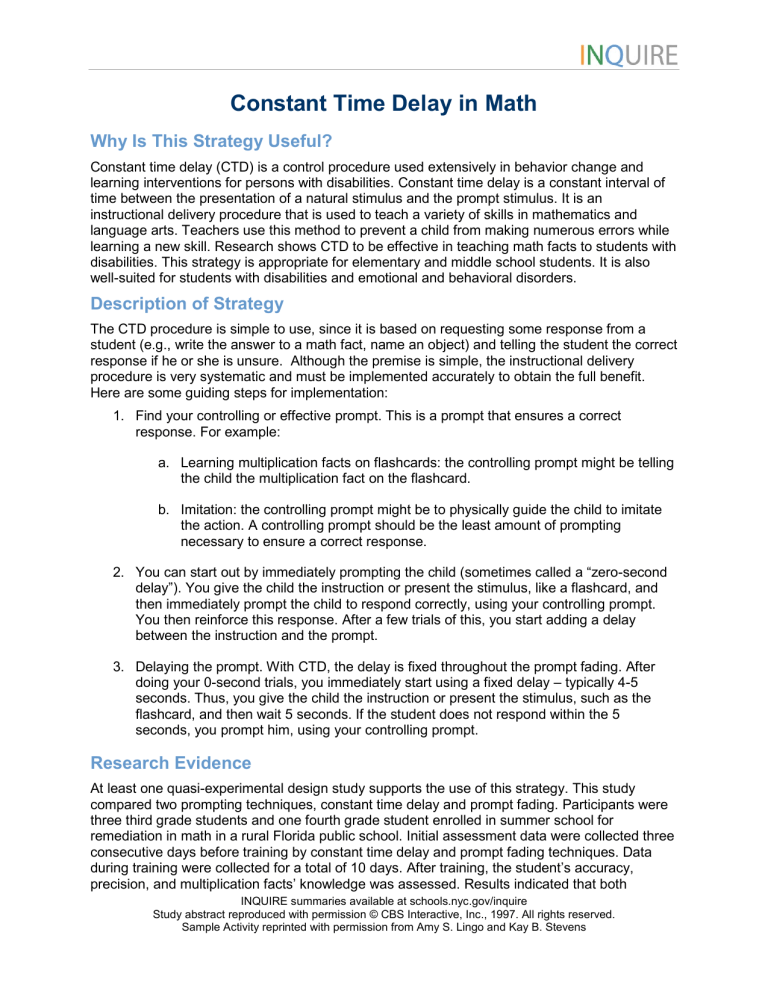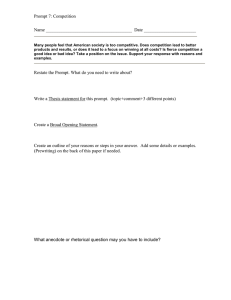Constant Time Delay Math Strategy for Students

Constant Time Delay in Math
Why Is This Strategy Useful?
Constant time delay (CTD) is a control procedure used extensively in behavior change and learning interventions for persons with disabilities. Constant time delay is a constant interval of time between the presentation of a natural stimulus and the prompt stimulus. It is an instructional delivery procedure that is used to teach a variety of skills in mathematics and language arts. Teachers use this method to prevent a child from making numerous errors while learning a new skill. Research shows CTD to be effective in teaching math facts to students with disabilities. This strategy is appropriate for elementary and middle school students. It is also well-suited for students with disabilities and emotional and behavioral disorders.
Description of Strategy
The CTD procedure is simple to use, since it is based on requesting some response from a student (e.g., write the answer to a math fact, name an object) and telling the student the correct response if he or she is unsure. Although the premise is simple, the instructional delivery procedure is very systematic and must be implemented accurately to obtain the full benefit.
Here are some guiding steps for implementation:
1. Find your controlling or effective prompt. This is a prompt that ensures a correct response. For example: a. Learning multiplication facts on flashcards: the controlling prompt might be telling the child the multiplication fact on the flashcard. b. Imitation: the controlling prompt might be to physically guide the child to imitate the action. A controlling prompt should be the least amount of prompting necessary to ensure a correct response.
2. You can start out by immediately prompting the child (sometimes called a “zero-second delay”). You give the child the instruction or present the stimulus, like a flashcard, and then immediately prompt the child to respond correctly, using your controlling prompt.
You then reinforce this response. After a few trials of this, you start adding a delay between the instruction and the prompt.
3. Delaying the prompt. With CTD, the delay is fixed throughout the prompt fading. After doing your 0-second trials, you immediately start using a fixed delay – typically 4-5 seconds. Thus, you give the child the instruction or present the stimulus, such as the flashcard, and then wait 5 seconds. If the student does not respond within the 5 seconds, you prompt him, using your controlling prompt.
Research Evidence
At least one quasi-experimental design study supports the use of this strategy. This study compared two prompting techniques, constant time delay and prompt fading. Participants were three third grade students and one fourth grade student enrolled in summer school for remediation in math in a rural Florida public school. Initial assessment data were collected three consecutive days before training by constant time delay and prompt fading techniques. Data during training were collected for a total of 10 days. After training, the student’s accuracy, precision, and multiplication facts’ knowledge was assessed. Results indicated that both
INQUIRE summaries available at schools.nyc.gov/inquire
Study abstract reproduced with permission © CBS Interactive, Inc., 1997. All rights reserved.
Sample Activity reprinted with permission from Amy S. Lingo and Kay B. Stevens
constant time delay and prompt fading were effective methods for teaching multiplication facts to learning disabled elementary students.
Sample Studies Supporting this Strategy
Morton, R. & Flynt, S. (1997). A comparison of constant time delay and prompt fading to teach multiplication facts to students with learning disabilities. Journal of
Instructional Psychology 24 (1), 3-11.
The purpose of this study was to compare the effectiveness of two prompting techniques for teaching multiplication facts to elementary students with learning disabilities. A response prompting technique, constant time delay, and a stimulus manipulation procedure, prompt fading, were used with each of four subjects. A variation of the multi-element baseline design was employed. The procedure combined measures used in precision teaching, median frequencies of correct and incorrect responses, accuracy multipliers, and acceleration of correct and incorrect responses over time, with the multi-element baseline research design. Rate data for each subject was graphed daily. Results indicated both procedures for teaching multiplication facts to elementary students with learning disabilities were effective.
Additional Resources
Time Delay. http://depts.washington.edu/pdacent/TIpsheets/Time%20Delay%20Tip%20Sheet.pdf
Hughes, T., Fredrick, L. & Keel, Marie. (2002). Learning to Effectively Implement Constant Time
Delay Procedures to Teach Spelling. Learning Disability Quarterly, 25 (3), 209-222.
Teaching Functional Life Skills to Youth with Disabilities. http://www.nsttac.org/pdf/life_skills_executive_summary.pdf
Sample Activity
Source : Constant Time Delay: One Way to Provide Positive Behavioral Support for Students
With Emotional and Behavioral Disorders http://www.ccbd.net/documents/bb/Spring2005pp10-
15.pdf
Zero-Second Time Delay Learning Activity
Instructional objective
When shown 30 multiplication facts 0 × 3 through 0 × 9 in random order on flash cards, the student will say the fact and answer before the prompt with 100% accuracy across three out of four instructional sessions.
Target content:
Multiplication facts 3 × 0 through 3 × 9 for a total of 10 facts.
Materials:
Thirty flash cards with one fact each (each fact repeated three times), data form, and pencil.
Trial sequence:
One session of 30 zero second delay trials (each fact repeated three times randomly). All subsequent sessions will include 30 three-second delay trials until the objective’s criterion is met.
Instructional time:
INQUIRE summaries available at schools.nyc.gov/inquire
Study abstract reproduced with permission © CBS Interactive, Inc., 1997. All rights reserved.
Sample Activity reprinted with permission from Amy S. Lingo and Kay B. Stevens
One or two sessions per day.
Teacher Antecedent
• “Al, let’s play time delay!”
• Show flash card (e.g., 3 × 4), make sure Al is attending, and immediately deliver the controlling prompt—say the fact and the answer to the fact (e.g., “3 × 4 = 12”) .
Student Response Options
• Correct Wait: responds correctly by imitating the prompt (e.g., “3 × 4 = 12”).
• Incorrect Wait: responds incorrectly after the prompt b y failing to imitate accurately
(e.g., “3 × 4 = 14”).
Teacher Feedback
• Response to “Correct Wait”: “Yes! 3 × 4 is 12. Good for you.”
• Response to “Incorrect Wait”: “No, 3 × 4 is 12. What is 3 × 4?” (Allow the student to correct the error by imitating the repeated controlling prompt.
INQUIRE summaries available at schools.nyc.gov/inquire
Study abstract reproduced with permission © CBS Interactive, Inc., 1997. All rights reserved.
Sample Activity reprinted with permission from Amy S. Lingo and Kay B. Stevens

